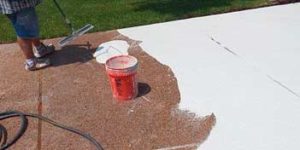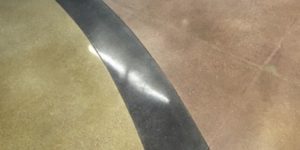Living by the motto “The customer is always right” can be frustrating and a painful experience in the decorative concrete world. Decorative concrete is a magnet for scrutiny. As an installer of architectural concrete finishes, you are held to a much higher standard than those pouring plain gray concrete. After all, you are dealing in color, texture and tone – in other words, art. The difference is that your canvas is concrete.
The ability to provide high-quality work, collect your hard-earned money, satisfy your customers and gain referrals can depend a lot of the time on steps you take before the job even starts. Troubleshooting means not only understanding what went down and solving problems after they occur, but also establishing a routine, working smarter, and setting yourself up for success before the work even begins.
Before you read any further, you all need to ask yourself a question: Why am I in this business? There really is only one reason, to make money. The ability to use your artistic talents to turn concrete into something colorful and unique is secondary. With decorative concrete, the client receives a value-added product, while the installer receives a significantly higher paycheck. This is as it should be, considering all the time, training, and risk required of you, the decorative concrete specialist. Doesn’t it make sense, then, that it would be a good idea to put even more thought into understanding, controlling and selling these value-added products and services you offer?
This is where the seven steps to success before you start come into play. Problems with architectural concrete projects, real or perceived, can all be traced back to a breakdown of one or more of these seven steps.
Whether you are established in the decorative concrete business or just getting started, think about your first stamp or stain projects. Remember the stresses of trying to remember all the steps, knowing when and how to apply the products, and worst of all, wondering if the colors will come out as promised. There is no easy road to being a great decorative concrete specialist. One problem can cost you all of the profit and momentum you have developed – and worse, can cost you your well-earned reputation as someone the industry can count on for quality work. Practice, practice, practice! I encourage you to not only read the seven key steps, but also actually try to incorporate them into future projects. These steps are designed to help you avoid certain problems, set yourself up for easier resolution if problems do arise, and increase your profit margin.
Step One: Understand the products and the process
I think step one has more to do with common sense than any age-old trick of the trade. Unfortunately, common sense is not always so common. It is always good to start with the basics, and that is just what this is. When is the last time you read a product label, reviewed the spec sheet, or sought factory advice on new and different ways of application? Take a class, talk to the manufacturer, and get your hands dirty! For those thinking about getting into architectural concrete, this exercise should be mandatory. If you don’t know how the product works, don’t have a basic understanding of what it’s made of, or have never been involved in its application, how can anyone realistically expect a professional outcome? You can enroll in the school of hard knocks and learn via trial and error, or you can take a few minutes and save yourself a fair amount of heartache, time and money.
I can’t tell you how may times I have received a call from a contractor on his or her way to a job, only to realize that they have neither the tools, the manpower, or the preparation in place to actually do the work. I am continually reminded of just how powerful the fallacy of easy money can be. The realization that decorative concrete pays more often clouds the fact that there is much more involved in product and application in order to earn that fat check. Take a moment to think – do you really understand everything about the process and the products you use every day?
Step Two: Manage expectations
I first heard about expectation management years ago from Steven Hicks, founder of ConcreteScience International. I immediately thought about how powerful this simple concept is in relation to decorative concrete troubleshooting. Manage your client’s expectations upfront. Underpromise and overperform in regard to application and a vast majority of potential perceived problems go away. Each year I am asked to troubleshoot hundreds of decorative concrete “problems.” I find that many of the problems are perceived. If the client’s expectations had been properly managed during the sale, the perceived problem would have never been an issue.
This is such a powerful concept in regard to architectural concrete because it involves color and design. The very thing that provides value and premiums can also cause significant loss of time and money if not managed properly before any contract is signed. What is common knowledge to you and me (colors in concrete can vary, stains produce variegated color tones, sealers require maintenance, concrete cracks, etc.) requires in-depth explanation to architects, general contractors and homeowners. Showing realistic, reproducible samples, explaining the processes, outlining the products’ limitations in contract form, and making sure your clients are comfortable with the required maintenance are all factors in managing expectations.
Step Three: Sell perception and value
While this step has less to do with avoiding problems and more to do with sales, it is important. If all you do is manage expectations, you won’t make much money. Decorative concrete provides the look of stone, tile, wood, or something totally unique, combined with the value of concrete. How often do you sell the benefits of decorative concrete? Try using words and phrases such as “unique,” “durable,” “endless color options,” “versatile” and “multifaceted” next time you sell yourself and your work. Always end with the understanding that this is an investment, not just a driveway, floor or wall. The commitment to and understanding of the investment from the client is what will make this partnership work.
Step Four: Do samples
What is standard practice before installing tile, wood, carpet, paint, or any common flooring or finish? Picking a color and style, bringing it home, and seeing how it looks in its possible new surroundings. Why should decorative concrete be any different? The decorative concrete sample process can be accomplished in many ways – having samples ready in advance, maintaining a showroom, making custom samples prior to each project, and applying various finishes to the actual floor, to name a few. A professional photo portfolio of your work also adds to the overall sample process. In my opinion, certain processes, such as staining, require mandatory on-site samples, while others, such as stamped concrete and overlays, can be illustrated with premade samples and showrooms. Make sure to note recipes, surface conditions, and application procedures so results can be reproduced years later. Sampling is the cheapest form of insurance any applicator can take out, so why don’t more take advantage of it? As a side note, once your samples are approved, keep them in a safe place. Too many times, I have seen situations where samples would have solved a dispute but were destroyed or covered up prior to job completion. If your work resembles the sample, disputes tend to be settled quickly.
Step Five: Build a resource network
Where do you turn when problems do occur? That stack of business cards of established and trusted industry specialists that you have been collecting for years is a good place to start. Product representatives, distributor sales staff, other installers, and artisans in related trades are often the most common people found in decorative concrete applicator resource networks. You can go looking when a problem occurs, but once again, planning ahead can save time and money when things turn ugly on a project. I need to stress how your local distributor’s sales and counter staff are invaluable in this situation. They quite often can get you in touch with people in the know when problems do occur. Other places to look include books, Web sites like ConcreteDecor.net, trade shows such as the Concrete Decor Show and World of Concrete, industry meetings, and publications such as the one you are reading right now. Too many times I’ve seen a small problem turn into a huge problem because an applicator did not know where to look or who to talk to.
Step Six: Take the systems approach
Almost all reputable manufacturers of decorative concrete materials (color, stain, overlays, sealers, etc.) design their products to work in conjunction with one another. Materials for surface preparation, coloring, cleaning, sealing, maintenance and even stripping are sold under one label. This is known as a system. Using a system will greatly help reduce potential problems. For one thing, reputable suppliers will have tested their materials to assure compatibility. This is worth its weight in gold both before the project, when you need advice or clarification, and when a problem occurs and you need only deal with one supplier to get resolution. Secondly, you simply can’t always be the one to make sure things are done as they are supposed to. Consistency in the system you use helps you develop a comfort level and allows for more reproducible results.
Step Seven: Be an expert
Continue your education as often as you can. Schools, seminars and product demonstrations are available everywhere. Take advantage of them. Be aware though, not all are equal. Do your research before spending any money. How much of the seminar is spent in classroom and how much in “hands-on” time? Exactly what products or techniques will be covered? Is the training so broad as to only be a “sales pitch” for a company, not information specific to your needs? Also, be wary of “deals” or “franchises” that are only available at a training event. Keep asking questions. Keep learning. Strive to be an expert on what makes you money!
The ideas discussed above only go so far. They won’t help much if the work is subpar or the actual products don’t perform as advertised. But the seven steps to success before you start are an important first part in avoiding and solving problems. The steps are common threads that wind their way through all decorative applications and projects. It is your responsibility to incorporate them into your everyday business.
















